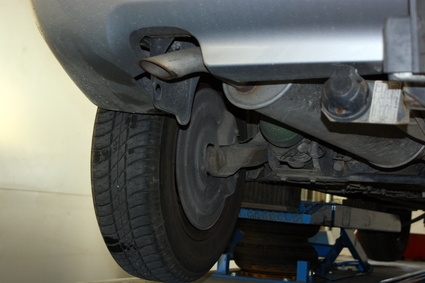
Struts absorb the movement of your vehicle as you drive over uneven road surfaces, making your ride smoother. When struts become worn, they will not dampen the movement, and the ride becomes bouncy and rough. Even if just one strut is worn, they need to be replaced in pairs. There is no set time to replace this type of part; it is done when the part is no longer doing an effective job of supporting the car. It may take some time to perform the task, but the process is relatively simple.
Lift the car with a jack and place jack stands under the rear frame of the vehicle to support it while you work.
Remove the rear tire on one side of the car with a lug wrench to loosen the lug nuts. Remove the nuts, pull the tire off and set them aside.
Locate the strut mount assembly and spray the nuts with lubricant. These areas will likely be rusted and dirty; the lubricant will help loosen any debris locking them in place.
Remove the bottom nuts from the knuckle assembly then remove the top three nuts from the strut mount assembly. Remove the strut from the car carefully.
Mount a spring compressor tool and collapse the spring on the strut. Mark the spring so you know which end is the top. Remove the spring nut and remove the strut from the spring. Do not remove the spring compressor tool from the spring; keep it collapsed until it is remounted on the new strut.
Position the spring on the new strut with the compression tool in place. Reassemble the mount and replace the retaining nut. Make sure the spring is in the seat correctly and, when everything is in place, begin to loosen the spring compression until it is fully extended on the new strut.
Maneuver the new strut into place and reinstall the bottom bolts. Reinstall the upper mounting nuts and tighten them into place. You may need to use the jack to lift or adjust the suspension slightly to do this as the new strut is not worn and may be slightly longer than the one you removed. Be sure everything is secured and in place, then remount the wheel on the car.
Repeat the steps as above for the other side.